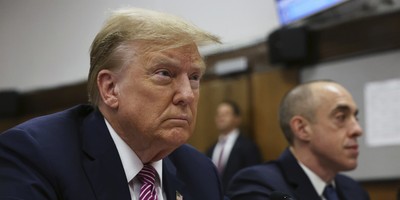Most presidents affect the standing of their political parties. Ronald Reagan advanced his party's standing among young voters. So did Bill Clinton.
In his first term, George W. Bush helped Republicans equal Democrats in party identification in the 2004 exit poll -- the first time that happened since polling began.
But in his second term, Bush proved toxic to the Republican label. The Pew Research Center showed Democrats with a 51 percent to 39 percent party identification edge over Republicans in its 2008 polls.
Now Pew Research has come out with figures for 2011. They're not good news for Barack Obama and the Democrats.
The Democratic Party identification edge has been reduced to 47 percent to 43 percent. That's a 4 point drop for Democrats and a 4 point rise for Republicans since 2008.
The Pew analysts note, as if they were analyzing a growth stock, that the Republicans' numbers haven't improved since 2010. But the 2010 numbers yielded a 52 percent to 45 percent Republican lead in the popular vote for the House.
If -- and it's always a big if -- Republicans can maintain that standing in party identification, they should be in fine shape in November 2012, even with increased presidential year turnout.
It's interesting to see which groups have moved most in party identification.
As the Pew analysts note, there has been little change among blacks, who are overwhelmingly Democratic. Hispanics come in at 64 percent to 22 percent Democratic, somewhat better for the president's party than last year, when they voted 60 percent to 38 percent Democratic in House elections.
But there has been big movement among whites. In 2008, they were 51 percent to 40 percent Republican. In the first half of 2011, they were 56 percent to 35 percent Republican -- more Republican than Southern whites were three years ago.
Recommended
The most noteworthy movement among whites has been among voters under 30, the so-called Millennial generation. Millennials voted 66 percent to 32 percent for Barack Obama in 2008 and identified as Democrats rather than Republicans by a 60 percent to 32 percent margin.
But white Millennials have been moving away from the Democrats. The Democratic edge in party identification among white Millennials dropped from 7 points in 2008 to 3 points in 2009 to a 1 point Republican edge in 2010 and an 11 point Republican lead in 2011.
There have been shifts of similar magnitude among whites who are low-income, who have no more than a high school education and who live in the Midwest.
It's not hard to come up with plausible reasons for these changes. Obama campaigned as the champion of "hope and change" in 2008 and assured crowds of young people, "We are the change we are seeking."
But the change they have seen is anything but hopeful. Youth unemployment rates have been at historic highs. Young people have seen their college degrees produce little in the way of job offers.
They are choosing more often to keep living with their parents. From the Obama Democrats they have gotten only a promise that "children" up to age 26 can stay on Mommy and Daddy's health insurance plans.
In the wake of the 2008 election, I argued that there was a tension between the way Millennials lived their lives -- creating their own iPod playlists, designing their own Facebook pages -- and the one-size-fits-all, industrial-era welfare state policies of the Obama Democrats.
Instead of allowing Millennials space in which they can choose their own futures, the Obama Democrats' policies have produced a low-growth economy in which their alternatives are limited and they are forced to make do with what they can scrounge.
There is little evidence that the Millennials believe their plight can be relieved and opportunities opened up by slapping higher taxes on Bill Gates and Steve Jobs or by restricting deductions for corporate jets, as Barack Obama urged in his Monday night speech calling for tax increases (although Senate Democrats gave up on them) in debt-ceiling legislation.
The intended purpose of legislation like the stimulus package and Obamacare was to improve the situations of those least able to take care of themselves -- the young, the less educated, the low-skilled. But it is just such groups that, the Pew Research Center numbers show, have been moving away from the president's party. An instructive achievement, no?

























Join the conversation as a VIP Member